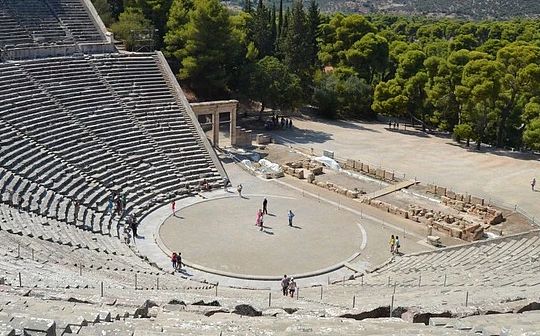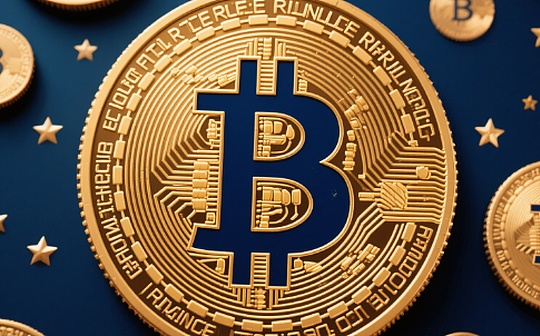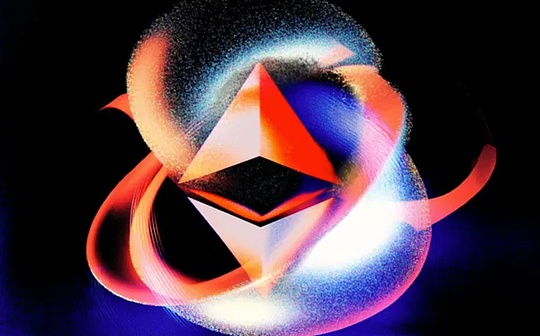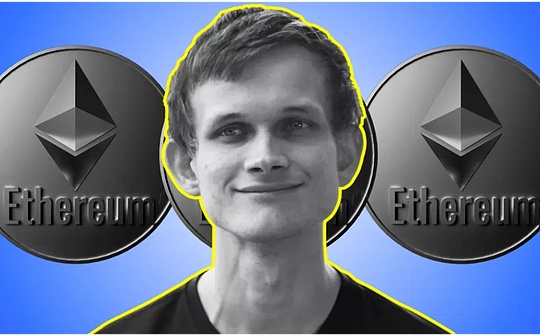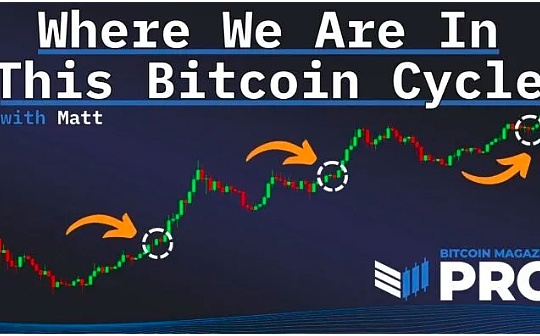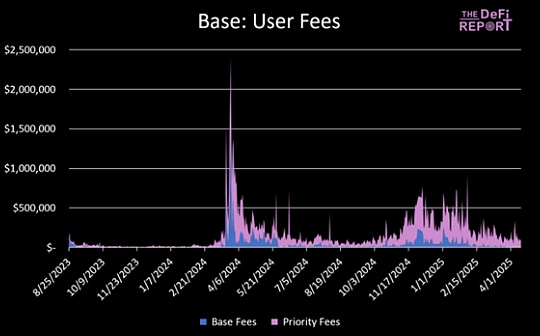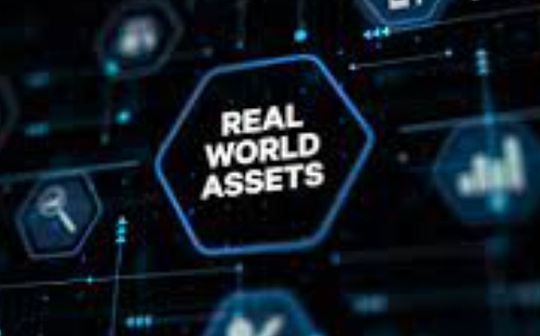
Author: Bib Exchange
RWA and assets have huge potential, which helps improve efficiency and shorten the settlement time on the one hand; on the other hand, tokenization will greatly improve the liquidity of assets, even in terms of risk control and investor protection.With difficulties, many mainstream institutions still have a strong interest in their future prospects.
On January 13, 2024, the World Financial Giant Bellaide CEO once said: Following the Bitcoin spot ETF, the next step is the stock, bonds, and all financial assets token.How to operate RWA and assets and assets, and what kind of development has become a topic that every industry must have awareness.
Background and principle
1.1 Develop background from reality
According to a report from Boston Consulting Group,By 2030, the market size of token assets is expected to reach US $ 16 trillion.This will account for 10% of global GDP in the late 2030sCompared with the US $ 310 billion in 2022, the increase is significant.This estimation includes fragmentation of assets of assets and traditional assets (Exchange Trading Fund ETFS, Real Estate Investment Trust Fund).
Considering the potential market size, even a small part of the market will have a huge impact on the blockchain industry.Even at the $ 16 trillion, token assets are still only a small part of the current global total asset value, estimated to be $ 9 million (less than 1.8%, and it has not considered the growth of global total asset value in the future).
It can even be considered that the real potential market is the entire global asset market, because anything that can be available can be represented on the chain as RWAS.The initial participants were assets such as Goldman Sachs, Siemens, KKR. Hamilton. BOC International -UBS and other institutions passed RWA as a mortgage proposal in the form of tokenized real estate, invoices and accounts receivables.
1.2 Basic principles
RWA is the Real World Assets (RWA) under the chain. It is brought to the chain through Tokenize as another source of revenue for the DEFI ecosystem.
Three steps of RWA:
The RWA process can also be said to be a chain packaging; Off-Chain Formalization, Information Bridging (token conversion or information bridge), and RWA Protocol Demand and Supply.
1) Packing under the chain
The assets are packed under the chain to comply with compliance to clarify the value of assets, asset ownership, and the legal guarantee of asset rights.Pay attention to the following dimensions:
value:The economic value of assets can be represented by the fair market value of assets in the traditional financial market, the recent performance data, physical conditions or any other economic indicators;
legality:The ownership of assets can be determined through deeds, mortgage, bills or any other form.
Legal support:In the case of changes in asset ownership or equity, there should be a clear solution process, which usually includes specific legal procedures for asset liquidation, dispute resolution and execution.
2) Information bridge
Data is on chain, and information about the economic value of assets and ownership and equity is brought to the chain after dataization.Among them, securitization: issuance of securities -type Token, KYC/AML/CTF, and on -shelter trading platform compliance.Regulatory technology/securitization: There are different regulatory technologies for assets that need to be supervised or regarded as securities, and the assets are introduced into DEFI in a compliant way.
3) RWA protocol requirements and supply
The entire process of promoting RWA through the DEFI protocol; In terms of supply, the DEFI agreement supervises the initiative of RWA.In terms of demand, the DEFI agreement promotes investors’ demand for RWA opportunities.Most of the DEFI protocol focusing on RWA is both the starting point of the new RWA and the market for RWA terminal products.
Digitalization of asset -asset standards -asset registration chain upper -ownership confirmation, for different real assets, different RWA pricing is required.Establish a quality assessment system for RWA, and study the value model of different industries and different types of data, and provide a basis for RWA transactions.At the same time, it is necessary to establish a trading, circulation platform and application market for digital assets. In fact, the data factor market of RWA is actually allowed to participate in circulation in the form of data elements.
Market application
Large narratives are often easy to carry greater funds and opportunities.Why the mainstream investment banks and consulting agencies in the United States are providing a strong endorsement for RWA.From the recent DUNE statistics, it is not difficult to find that the past net inflow of RWA has continued to rise in the last month of 2023.
>
Market case
The stable currency based on fiat currency is the original RWA, and then a series of assets include: commercial real estate, bonds, artworks, real estate, automobiles, and almost any storage value of assets. Of course, as the most popular foundation for RWAThe asset category is real estate, followed by climate -related foundation (such as carbon credit quota) and public bond/ stock basis, followed by the foundation of emerging market credit (mainly corporate debt).Analysis of some typical RWA projects in the market, mainly the following more important cases:
2.1 Treasury asset allocation US debt
MakerDao first also involved real estate and other assets, considering the risk of default in assets.The stable currency agreement such as MAKER uses the Treasury assets to allocate U.S. debt to indirectly obtain the return of US debt.At first, it was used as a USDC, facing the risk of getting off the anchor in the later period, most of which were US Treasury bonds.MakerDao mainly purchases U.S. Treasury bonds, and does not adopt an asset issuance platform. Instead, it holds U.S. debt assets through a trust legal structure.MakerDao entrusted Monetalis to design an overall legal architecture, and Monetalis is based on the British Viking Islands (BVI) trust legal architecture to realize the opening of the chain.
MakerDao’s stablecoin DAI linked to the US dollar is one of the most common use cases in RWA.MakerDao is also a DEFI protocol that has included RWA into a strategic planning earlier. 2020 passed RWA as a mortgage proposal in the form of tokens, invoices and accounts receivable to expand the DAI issuance.The asset scale of more than 3 billion U.S. dollars is currently.MakerDao allows the borrower to deposit mortgage assets into the “vault” so that the borrower can withdraw the debt of the protocol Native Stablecoin DAI (USD -based pricing).The vault is a smart contract. It holds a borrower based on Ethereum mortgage and until all the borrowed DAIs are returned.As long as the value of the mortgage remains above the specific threshold, the relevant liquidation mechanism will not be triggered.
Here we need to emphasize the typical project of MakerDao -New Silver.As the first formal actual World Assets (RWA) project in MakerDao, it was established in 2021 and its debt limit was $ 20 million.The underlying asset of the project is NEW Silver’s assets of the sponsor, and the issuer SPV set up under New Silver is financed at the Centrifuge tokens.
In November 2022, the community proposed to upgrade and reorganize the New Silver project in 2021, and adopted a trading architecture of the Foundation +SPV.This upgrade fully follows the transaction architecture, so that MakerDao is fully controlled at the level of legal entity governance.In the new Silver RESTRURURING upgrade and reorganization trading architecture, the main participants include:
:RWA Foundation: It was established in 2021 and operated the previous Huntingdon Valley Bank project.Controlled by MakerDao, the Director of the Foundation must make a resolution or exercise any rights based on MakerDao Resolutions.Through the governance system on the chain and under the chain, MakerDao can fully control the project.
NS Drop LTD: It is a wholly -owned subsidiary of the RWA Foundation and is the main body of the transaction.Participate in the subscription of the Drop token initiated by the financier and provide funds.As a token holder (Drop/Tin), he exercises the relevant rights entrusted by MakerDao Resolutions.The trustee’s ANKURA TRUST conducts asset operations according to the trust agreement.
Ankura Trust: Established to ensure the security of the issuer’s SPV assets and the security of MakerDao funds.According to the trust agreement between SPV and the trust company, the mortgage of SPV credit assets and the pledge of SPV equity are agreed to ensure that MakerDao’s assets are complete and deal with breach of contract in time to ensure the security of MakerDao funds.
>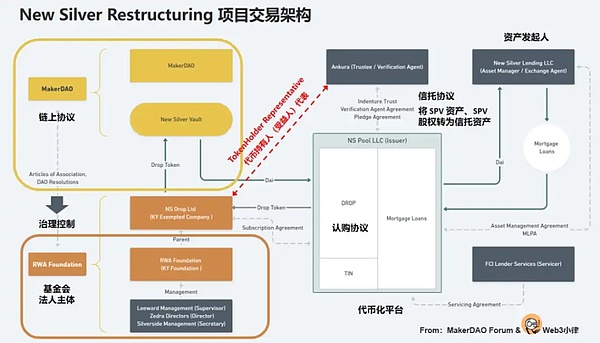
2.2 Investment ETF
ONDO Finance launched a tokened fund as the DEFI protocol, which launched its OUSG tokens on the Polygon network, allowing stable coins to invest bonds and US debt.ONDO Finance has now supported four investment funds -US Monetary Market Fund (OMMF), US Treasury (OUSG), short -term bonds (OSTB), and high -yield bonds (OHYG).Fund tokens).After the user can trade the fund token after the KYC/AML process, and use these fund tokens in the license DEFI protocol.
The ONDO Finance team also developed a decentralized lending agreement Flux Finance, and FLUX specially invested in the Ishares short -term TEF (SHV) of Ishares Treasury in Berlaide.The protocol provides a variety of tokens available to borrowing, such as USDC, DAI, USDT, and FRAX, and OUSG is the only mortgage asset.
Flux Finance allows OUSG to pledge OUSG to borrow stablecoins.As a stable currency provider in the Flux Finance borrowing pool, it can obtain the income of investment in US debt without KYC.
2.3 SPV tokenization +DEFI protocol
In terms of reducing investment threshold exploration, MATRIXPORT launched a non -permitted US debt investment agreement T Protocol.MatricDock, a chain bond platform launched by MatrixPort, chose a way to establish a special purpose company (SPV) as a publisher to buy and hold US Treasury bonds.
MatricDock launched a US Trek -based product SHORT -TERM TREASURY BILL token (STBT), receiving short -term Treasury token STBT issued by MatrixDock as a mortgage, and opened a low -risk lending of US Treasury bonds.Through the pool, users can deposit stable coins to earn borrowing interest, and the borrowing interest rate is expected to be about 5%.Users who deposit stable coins in the pool will receive the borrowing voucher to the token Rustp.According to compliance, it still requires customers to perform KYC and register the address as a list of white lists, with the minimum investment of 10USD.
After investors deposit stable coins into T Protocol, TJTCOCOL casts TBT. When it accumulates 100,000 USDC, entrusts partners to buy STBT.TBT anchor $ 1 and can be redeemed by agreement to issue US debt income in a REBASE manner.Another WTBT is a non -Rebase method for TBT.Behind TBT is the agreement to purchase S T B T and the USDC reserves Talocol, which can purchase STBT in the future, is equivalent to the intermediary between non -MatrixDock users and MatrixDock.TBT is also a potential competitor of stable coins.
2.4 Algorithm stabilization currency protocol
FRAX Finance has also explored RWA assets such as US debt.FRAX Finance and Makerdao have had similar dilemma before, that is, over -dependence on USDC as mortgages. At the beginning of this year, USDC’s anchoring caused DAI and FRAX to fall below $ 0.9, further forcing Frax Finance to strengthen reserves to reduce dependence on USDCEssence
AAVE native stablecoin GHO launched the test network. GHO is an excess mortgage stable currency supported by multiple encrypted assets.Subsequently, the lending agreement Centrifuge proposed to introduce RWA into AAVE and use it as a mortgage for native stablecoin GHO.As a RWA provider of AAVE, CENTRIFUGE enables AAVE to earn benefits for real -world mortgages. At the same time, the initiator of Centrifugs assets can borrow funds from AAVE.
2.5 US debt / fund tokenization
The RWA tokenization method is achieved by launching a short -term US debt -based compliance fund and using the transaction data of the fund on the chain to achieve the “fund share tokenization”.The form of the fund share of traditional financial institutions; the fund of the COMPOUND chain bond company, the fund, will invest in “ultra -short -term government securities”, including U.S. Treasury bonds, government agency securities and other government -supported tools.
Holding fund tokens and investment funds have the same requirements. The holders of the fund share tokens need to register the address as a whitening list of the fund.Residents only support fiat currency transactions and do not support cryptocurrency transactions such as stable currency.
Remaining cases
Of course, the following TRON, STUSDT, Securitization / Tokenization, Strikex (Strx), Inx Crypto Trading Platform (Inx), Curio Group (Cur), etc. ETIX and Mirror Protocol are decentralizedStock transactions on the synthetic asset agreement chain were originally synthetic assets, carbon credit vouchers Klimadao and Toucan, precious metal PAX, PolyMeth of L1, real estate token Labs Group, multi -asset token PAXOS, Tradfi Polytrade.Small, so I won’t go into details here.
Way of operation
RWA does not mean that the funds flow out of DEFI, but the money circle funds try to eat Tradfi, involving a complete mechanism of the borrowing parties.Here will be a detailed decomposition of several modes of MakerDao’s RWA:
3.1 USDC institutional reward plan for participating in Coinbase Prime RWA014
The USDC custody of the institution to the Coinbase Prime account custody fee is 0, and the reward will be given monthly. Coinbase promises not to lend, pledge or pledge the assets in the accounts of customers, and promise that customers can cast, destroy, and extract almost immediately.And settle USDC (& lt; 6 minutes).
Because the USDC’s own reserve assets issued by Coinbase and Circle invested in US debt, the Coinbase Prime plan was not to make a direct profit, but for the development of the entire USDC ecology, grabbing market share (equivalent to the income of the US debt of reserve assets,Give a big house, USDT does not have this kind of benefit.
The proposal also mentioned two operation processes, which may need to analyze the contract to determine which one of the final use.
Operation method (1):
(I) The mortgage RWA014-A cast DAI, the stability rate is 0%, and the mortgage rate is 100%.
(Ii) Use DAI to exchange USDC 1: 1 in PSM.
(III) USDC stored in the account opened by MakerDao on Coinbase Prime
Operation method (2): The USDC in the PSM pool is directly transferred to the USDC in the PSM pool to the account opened by MakerDao at Coinbase Prime.
3.2 Cooperate with the asset tokenization agreement RWA002-006, RWA010-013, RWA015
Consolfreight via Tinlake (the bottom is the Centrifuge protocol, basic simulation of traditional financial SME credit) to package his receivables into NFT assets, and Tinlake will divide the entire NFT claim into the priority tokens DROP (fixed interest rate) andInferior tokens Tin (floating interest rate) to sell financing.MakerDao uses DAI to buy Drop tokens as priority creditors.The part of the chain is basically responsible for the Centrifuge protocol, and most of the RWA of Makerdao uses this model.
MakerDao issued the first RWA002Vault with New Silver through Centrifug in February 2021.After that, the larger -scale introduction of RWA has been based on the SPV tokenization path.The RWA business model of MakerDao Center’s RWA business model is as follows:
Asset Originator set up a legal entity for each pool, SPV.The purpose is to isolate financial risks, providing funds for the basic assets of specific RWA as a specific Centrifuge pool;
The borrower has transformed the assets under the chain to NFT through AO (underwriters) for NFT for mortgages on the chain;
The borrower signed a financing agreement with SPV and asked AO to lock its NFT in the Centrifuge pool bound to SPV;
After the NFT was locked, DAI was extracted and transferred from the Centrifuge reserve to SPV’s wallet. The SPV wallet was exchanged for DAI to the US dollar, and transferred to the borrower’s bank account through banking;
On the NFT expiration date, the borrower repay the financing amount and the financing fee.The repayment method can be repaid directly on the chain with DAI, or it can be transferred to SPV with US dollars.SPV exchanges the US dollar to DAI and pays it to the Centrifuge pool.After full repayment, the locked NFT will be returned to AO and destroyed.
3.3 Models based on trust and asset securitization companies RWA001, RWA008, REA009
Asset securitization companies divide long -term lease financing bonds into priority and inferior rear levels. The priority is borrowed from the MAKER protocol in the form of debt, and the inferior background is composed of other external investors.DAI was cast into the ETH address of the TFE (tax discount entity), and then transferred from TFE to a specific “trust” account (or its equivalent account) in the jurisdiction.From there, when LENDCO was called, DAI borrowed it from a trust, thus eliminating DAI’s hosting risk (it is understood that the trust company was also established by the MakerDao team).Lendco is responsible for redeeming the legal currency and DAI at the diplomatic trading mall’s diplomatic counter.
3.4 Lobarous bond strategy based on Monetalis Clydesdale RWA015
Monetalis provides a complete set of solutions and reports to MakerDao. It mainly invests in short -term bond ETFs (mainly the BlackRock Fund’s Treasury Coupon ETF).This model is basically similar to the third, and it also needs to follow the trust model and fund process that follows the No. 21 proposal, but the trust part is provided by a third -party Monetalis.First of all, you need to use the generated RWA tokens to cast DAI, the stable fee is 0%, and then use DAI to exchange USDC/USDP in the MakerDao PSM pool, and then buy Monetalis to buy US debt. The interest is manually paid by Monetalis.Asset allocation strategies, mortgage value assessment, whether the authority starts liquidation is in MakerDao.
3.5 indirect introduction of RWA income
Defi native applications want to carry out the RWA business generally have two ideas: one is to build a project directly based on the RWA income, and the other is to indirectly introduce RWA income as agreement revenue.At present, the largest RWA assets held by MakerDao are Monetalis Clydesdale.The purpose of MIP65 is to obtain more stable returns with part of the stable coins held by MakerDao, and the method is to invest in high -current and low -risk bond ETFs.
Monetalis Clydesdale’s RWA business model implementation path is as follows:
MakerDao voted after passing the approved Monetalis as the executive to report to MakerDao regularly;
As a project planning and executor, Monetalis has designed a set of BVI -based trust architectures (as shown below) to pass the synergy on the chain and under the chain;
All MKR holders of MakerDao are the overall beneficiaries and issue instructions to the purchase and disposal of trust assets through governance;
Coinbase provides the exchange service of USDC and USD;
Funds are used to invest in two types of ETFs: Ishares us $ Treasury Bond 0-1 YR UCITS ETF and BlackRock’s Ishares US $ Treasury Bond 1-3 YR Ucits ETF;
The US debt ETF income belongs to MakerDao, and MakerDao will divide the agreement income to DAI holders by adjusting DAI’s deposit interest rate.
3.6 Asset -based support model
This type of tokens is a new securities to represent the economic rights of underlying assets.Asset issuers will issue asset issuance and register assets and register assets outside the blockchain. After purchasing assets from third parties, token is issued according to the corresponding proportion relationship. The opponent’s risk is the asset issuer (Asset Isuer) and the asset-asset-BackedToken issuer).Backed Finance is a regulatory agency headquartered in Switzerland. Under the DLT bill of Switzerland, the real -world securities can be chained through the form of packaging and gives token economic rights.
Backed Finance bought the corresponding assets through a third -party institution. After the licensed custodian custody, the corresponding tokens issued the corresponding tokens through Backed Finance.It will involve other rights such as stock voting rights.The current assets issued include assets such as coinbase stocks, and BlackRock Ishares ETFs. Asset issuers are issuers corresponding to the underlying assets, such as Coinbase’s shares.There are at least two layers of risk of opponents, which come from Coinbase and Backed Finance.Backed Finance is a typical project that uses asset -supported models to issue the corresponding tokens. It also clearly states that the token only tracks the price of the underlying assets (Tracker of the Underlying), and does not hold other equity of the securities.Essence
Project and platform
4.1 Origin from traditional financial giants
What are the projects for RWA?In fact, most of us are the RWA of the narrow Crypto related sector. The RWA is not only reflected in simple national debt, but also has RWA projects in many industries and levels. Through the figure below, we can see the current carbon energy projects and consumption consumption.Projects, cryptocurrency trading, fintech, real estate, automation projects, etc. have all borrowed projects.
>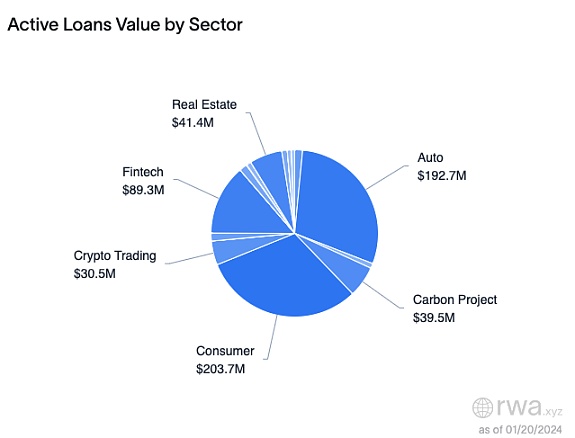
The first is that traditional institutions Franklin Templeton and Wisdomtree are traditional financial institutions. By conducting national bonds tokensize experiments on the public chain Stellar, trying to use blockchain technology to change the traditional financial business model.The project involves a national bond token, and the traditional Treasury assets that are about to be converted into digital tokens.Stellar is selected as the experimental public chain platform.Stellar provides fast and low -cost transactions, and handles asset issuance and exchange in a decentralized manner.Although it is carried out on the public chain, the project mainly uses centralized equity registration.This means that the ownership and transaction records of the tokens may register and manage the centralized entities (maybe financial institutions).
This experiment may be a step for traditional financial institutions to gradually accept and integrate blockchain technology.There may be more attempts in the future, and it is possible to gradually achieve a greater degree of decentralization in terms of technology and supervision.Franklin Templeton and Wisdomtree conducted the Treasury Bonding experiments on Stellar to explore the exploration of blockchain technology in traditional financial institutions, although it is currently more inclined to use centralized equity registration.This reflects the supervision and risk considerations faced by the financial industry when adopting new technologies.
>
We can clearly see through the graphics above and the table data below. At the end of 21 and early 22 years, the amount of RWA has attracted a huge outbreak, and then it is stable.The pattern of handling together.
>
4.2 Comparison analysis of several major lending platforms and service providers
CenterAs one of the earliest RWA DEFI protocols, it is also a technical provider behind the head protocols such as MakerDao and AAVE. It is a credit ecosystem on the chain.Method of liquidity.Centrifuge Prime includes a compliance legal framework for the DAO and DEFI protocol, complex tokenization and distribution platforms, decentralized and objective credit risks and financial reports, as well as diversified asset categories and issuers.Many about KYC and legal pursuits.Each asset sponsors on Centrification need to set up an independent legal entity for the capital pool, that is, special destination entities (SPV).
In terms of summary, the relationship between assets, issuers, investors, investors and Centrifuge in Centrifuge, and the specific investment and financing process are as follows:
(I) The borrower is mortgaged on the chain through the real estate
(Ii) The SPV is set up by the initiative of assets (one fund pool may be different borrowers)
(III) Asset initiator initiated and verified RWA, and casts NFT
(IV) The borrower signed a financing agreement with the SPV to mortgage the NFT in Tinlake, Tinlake pool cast Drop or Tin tokens.
(V) CENTRIFUGE and Securities cooperate to help investors complete the KYC and AML processes.Securitize is an SEC license institution that provides qualified investor verification services
(VI) Investors signed an investment agreement with the SPV corresponding to the Tinlake pool. The agreement contains the investment structure, risk, terms, etc., and then use DAI to buy Drop or TIN tokens.
(VII) When an investor provides DAI liquidity for the corresponding fund pool, SPV converts DAI to the US dollar to transfer the borrower’s bank account.
(VIII) Investors can request redeem their Drop or Tin tokens at any time, but it must ensure that the DROP token is better than the Tin token redemption, and the TIN tokens cannot be lower than the setting of the setting.
(IX) The borrower paid the financing amount and financing costs when the NFT expired, and the NFT was returned to the initiator of the asset.
ClearPoolIt is a decentralized credit agreement that provides an unsecured loan for institutions.Users can use a variety of currencies such as BTC/ETH/OP for borrowing, and lenders can only provide liquidity to their invited institutional fund pools.CPOOL is the governance tokens of ClearPool. Its main role is to have two aspects: on the one hand, the holder can vote for the new borrower’s whitelist.On the other hand, from the ClearPool prophecy machine to obtain benefits.In addition to getting normal USDC interest, borrowers can also get dual rewards paid by CPOOL.
The main features and the use of blockchain and smart contracts to achieve transparent and automated borrowing governance.With changes in market dynamic supply and demand, the interest rate of interest rates rose when the gap is high.This platform uses algorithm rating models and external rating API to evaluate user risks for users’ decentralized rating.
GoldfinchIt mainly provides loans for debt funds and fintech companies, provides a USDC credit limit for borrowers, and supports converting it into a legal currency for borrowers.Goldfinch’s model is very similar to traditional finance banks, but it has decentralized auditors, lenders and credit analysts.The auditors of the Goldfinch audit borrower must have a pledge governance token GFI.Main features:
Decentralized P2P lending platform -allow borrowers and lenders to directly borrow on the platform without intermediate institutions.Loan pools and credit scores: The debt fund provides credit rating to the borrower by evaluating and scoring algorithms to provide them with appropriate loan clauses.High -risk borrowers need to pay higher interest rates and mortgages.Relying on decentralized auditors and governance processes to ensure the safety and sustainability of the agreement.Reduce the role of centralized institutions.Charge interest / cost from the borrower.Some profits are allocated to the governance token holders.Its innovation combines traditional credit with decentralized finance / blockchain technology.More efficient and transparent P2P lending.Provide wider financial access and inclusiveness.
MapleIt is mainly for institutional accounts. Non -full mortgage loans are even in unsecured models. MAPLE will use professional credit reviewers to strictly audit the credit of borrowers.Institutional borrowers, lenders, and capital pool verification.The lender provides funds available for borrowing, and as the borrower, the verified person will review the qualifications of the borrower, and the borrower needs to pass the compliance requirements such as KYC and AML.To ensure the efficiency and safety of lending.
Therefore, MAPLE has been audited and rated by corporate assets with real asset mortgage loans as encrypted assets, and converted into RWA tokens circulating on the chain.Provide enterprises with new channels for mortgage financing.By introducing institutional investors to reduce corporate financing costs and provide investors’ new mortgage encryption assets.However, with thunderstorms such as Three Arrows Capital, FTX, MAPLE has a bad debt of $ 52 million, and it is controversial because the borrowing requires KYC without enough centralization.
In November 2023, Credix Finance, the Defi Credit Market, announced that it had obtained a US $ 60 million in credit integration. The company focused on asset -based loan opportunities and managed a $ 3 billion investment portfolio.For different categories such as supporting personal loans, corporate loans, Invoice loans.The more interesting project is Phantom and Solflare based on the popular browser wallets on Solana.For borrowers, it is also a multi -signing wallet. Relatively speaking, this platform is more inclined to blockchain projects with platform distribution fixed income products.
TruefiIt is an unsecured credit agreement driven by a credit score on the chain.Since its launch in November 2020, TrueFi has issued more than $ 1.8 billion of loans to more than 30 borrowers and paid more than $ 40 million in interest to the agreement participants.The borrower includes leading cryptocurrency institutions, as well as fintech companies, credit funds and traditional financial companies.
TRUEFI introduces an unsecured loan model, where the borrower does not need to provide traditional collateral, but instead evaluates its credit risk through the platform’s trust system.This is an innovation that needs to provide physical collateral in the traditional financial system.TrueFi’s two products: TrueFi Lend allows users to provide funds to obtain interest; TrueFi BORROW allows users to borrow through mortgage encryption assets.The TrueFi platform uses Trusttoken (TUSD) as its basic currency, which is a stable currency linked to the US dollar.I believe everyone is no stranger, especially the recent TUSD anchor.
Of course, there are other projects, including AAVE, which is well known, not only a decentralized borrowing agreement on Ethereum, but also a RWA project to some extent, supporting deposits and borrowings with a variety of digital assets.In terms of RWA, AAVE explores the possibility of introducing real -world assets such as real estate into its agreement, and also continuously experimented with many realistic assets.
At present, RWA is directly sold B2B, and directly sells B -end users such as institutional investors with RWA assets. The actual B2B2C model is actually used by C -end users.As the underlying mortgage asset of the structured DEFI product, RWA sells it to the C -side user Angle Protocol through the DEFI platform (the underlying asset is Backed Finance BC3M), and the USDV (the underlying asset is MatrixDock STBT), and the TPROTOCOL (the underlying asset is MatrixDock S TBT), Mantle Musd(Can be exchanged for ONDO Finance usdy) and Flux Finance (the mortgage is ONDO Finance OUSG).
This model has accelerated the promotion of RWA assets in DEFI, and also provides users with more diversified product choices.Here we will not list them one by one, but most of these projects are currently issued based on traditional financial assets and need to explore other forms of innovative projects.
4.3 Ecological Project
Since as investors in the currency circle, we may be more concerned about the investment value of these RWAs in the market, what are the emerging projects worth investing in the market, and what ecology does RWA have?First of all, let’s take a look at the summary of the entire RWA combined with CMC and non -trumpets.
>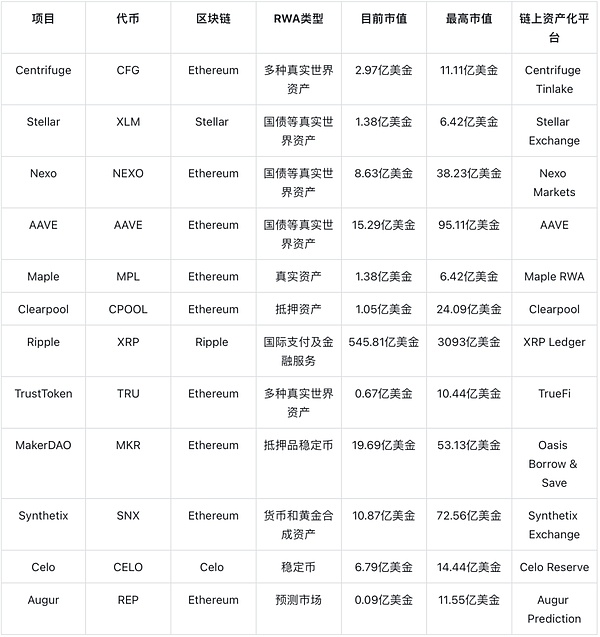
TAC token industry alliance
First of all, it is necessary to focus on the establishment of the token industry alliance, that is, the tokens -based asset alliance (TAC) jointly sponsored by companies such as Coinbase, Circle, AAVE, etc., showing the common interest of the cryptocurrency industry in the crypto industry.The alliance is committed to promoting the popularity of RWA globally and considering the principle of formulating compliance to promote the use of blockchain technology, including Base, CentrifUge, Credix, Goldfinch, RWA.XYZ, etc.We can look at some of the newly added emerging projects that have been added in the list.
>
Through this list, especially the 15 institutions or projects that joined on January 16, 2024, we can find that there is actually a particularly interesting phenomenon: that is, many public chains and well -known projects, including the well -known Chainlink, Polygon Labs, Solana Foundation, etc., also scrambled to join the alliance.What does this reflect?It shows that the native blockchain projects are also gradually joining traditional finance and continuously strengthen cooperation with real world assets.
>
New track and new project
Secondly, it is necessary to pay attention to projects that emerge from different tracks, including real estate, multi-assets, traditional finance (Tradfi), Layer-1 blockchain, climate/ renewable energy finance (REFI), agriculture, authentication, private equity, public equity, public equity, public equity, Private fixed income, public fixed income, emerging markets, securities tokens, etc.Refer to public information and count the following table classification.It is not difficult to find that there are many high -quality projects that have not yet issued tokens. For example, Credix based on SOL chain, such high -quality projects are worthy of attention.
>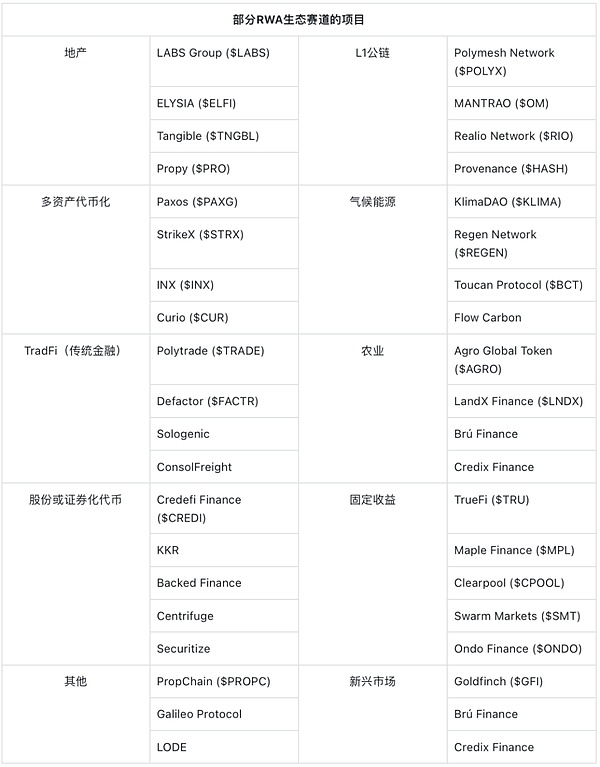
RWA’s supervision, suspicion and challenge
In the final analysis, RWA is securitized on the chain of offline assets, so we cannot ignore the implementation of the traditional financial market for related supervision for related supervision of offline assets.Especially for the innovation of digital asset centers, it looks easy, but there are strict restrictions.
5.1 Regional supervision
1) Singapore law punishment
Singapore has won the reputation of cryptocurrencies due to its early industry regulatory measures and the consulting method of regulators.However, although Singapore may fully support asset currency, it actually does not “encrypted friendship” at all.Singapore financial regulatory agencies are basically the same.Last year, Ravi Menon, managing director of the Singapore Financial Administration, delivered a speech entitled “Supporting digital asset innovation and opposing cryptocurrency speculation”.In 2023, he further stated that cryptocurrencies “did not pass the test of digital currencies.”
The first is about Singapore’s identification of cryptocurrencies. For example, in April 2023, in the case of the ALGORAND Foundation seeking clearing Three Arrows Capital Singapore entity and claiming 53.5 million USDCs, the Singapore High Court ruled that she did not recognize cryptocurrencies as currencies, and eventuallyReject Algrand’s liquidation application.
At the same time, Singapore’s supervision of cryptocurrencies is particularly strict, even if the source of third -party funds is traced back.In September 2023, in August, Singapore cracked the largest black laundering case in recent years. 10 people including Su Baolin, founder of Xinbao Investment, were arrested, involving money laundering activities worth more than 2.4 billion new assets.At least one international bank is closing some accounts with Cambodia, Cyprus, Turkey, and Vanuatu.Other banks in Singapore have begun to evaluate whether to accept new funds similar to background customers based on the case. This process takes longer.
At least 10 local and international banks in Singapore have been involved in the money laundering scandal that has attracted much attention, which has aroused the attention of its efficiency in cracking down on illegal profits.Singapore Congress raised more than 30 questions in Congress this week, covering the rigor, suspicious transaction reports of their censorship procedures, and the influence of Singapore’s reputation as a wealth center.
2) High threshold in Hong Kong
In June 2023, the Hong Kong Securities and Futures Affairs Supervision Committee (SFC) began to accept the application of the Cryptocurrency Exchange.On the surface, Hong Kong seems to be more friendly than Singapore’s cryptocurrency transactions.For example, Hong Kong regulators urge banks to accept more cryptocurrency exchanges as customers.But similar, there are many conditions for this kind of friendship.There are still only two licensed exchanges in Hong Kong, only spot transactions and limited token lists.98% of the exchanges must be stored in cold wallets.The exchange must also set up a legal entity in Hong Kong for hosting.It is neither simple nor cheap at the Hong Kong business exchanges, because it requires a team consisting of lawyers, consultants and insurance providers.So far, only the two OSL and Hashkey agencies have passed. In August 2023, the two platforms announced on the same day that they were approved by the CSRC to complete the license upgrade, which can provide virtual asset transaction services to retail customers.
We used to apply for a blockchain license in Hong Kong through the gossip consultation. The quotation is very high price. There are special intermediary quotations or even 100 million US dollars.The process is relatively cumbersome and the time cycle is relatively long. Even the wealthy institutions such as Binance have eaten this license when they apply for this license, and they will not be handled at the end.Stocks.
3) Japan’s high taxes
Japan has shown a relatively positive position in cryptocurrency supervision, and has taken some measures to ensure the transparency and security of the industry.However, high tax and strict issuance standards may become a challenge for enterprises to develop in the country.The Liberal Democratic Party of Japan clearly stated that Japan would make Japan the capital of Web3.Japan’s main obstacle to the destination of cryptocurrency entrepreneurs may be high taxes.
After the Coincheck hacker incident in early 2018, Japan’s regulators have adopted a very strict attitude towards cryptocurrencies, causing some people to worry about local industries in crisis.After the FTX collapsed in November 2022, Japan’s regulatory method was considered a major victory.Japan demands that the cryptocurrency exchange separates exchanges and customer assets to help users truly recover funds.Japan was one of the earliest major economies to implement stable currency supervision, but set higher standards.Only banks, trust companies, and capital transfer service agencies are allowed to issue stable coins, and they must comply with strict requirements, including 100% assets in Japan’s trusts, and can only invest in domestic bank accounts.
4) The United States diversified attitude
Cryptocurrency advocates often criticize the US government, especially the chairman of the US Securities and Exchange Commission Gary Gensler because they are not friendly to cryptocurrencies.The greater problem is not that the supervision is too harsh, but that people are still arguing what is securities and what is commodity.The US Securities and Exchange Commission (SEC) has repeatedly filed complaints.Many people in the industry are concerned about the Ripple court’s judgment, hoping that it can establish a clarified precedent.The business related to cryptocurrency may be supervised by the Anti -Money Laundering Regulations of the US Treasury.
SEC Supervision: The US Securities and Exchange Commission (SEC) supervises the RWA project involving securities.If RWA involves securities, such as fundraising through the form of tokenization, token issuance is regarded as securities issuance, and ICOS (first token issuance) then related issuance may need to comply with SEC securities regulations.
CFTC Supervision: The Commodity Futures Trading Commission (CFTC) supervises the RWA project involving goods.Some real assets, such as goods, may be supervised by CFTC.
State -level supervision: Some states may have independent financial regulatory agencies and may also supervise the RWA projects.The regulations in each state may be different.
Therefore, the United States has a diverse trend of the supervision of the real asset chain (RWA) and the blockchain, involving regulatory agencies and regulations at different levels.Blockchain technology and encrypted assets involve the attention of multiple regulatory agencies.Many institutions such as SEC, CFTC, and US Treasury may involve the supervision of blockchain and encrypted assets.
5) EU standard framework
Here we have to talk about the EU’s policy on cryptocurrency MICA.The MICA Act is a framework proposed by the European Union to provide clear legal regulations and regulatory standards for crypto assets on the market.The bill is the EU’s first comprehensive law framework for digital assets and cryptocurrencies.The MICA Act covers a series of matters related to cryptocurrencies, including the definition of encrypted assets, the registration and supervision of market participants, the rules of issuance of crypto assets, and the requirements of compliance reports.
The MICA Act stipulates that any market participants who provide crypto asset services in the European Union need to register at the European Securities and Market Supervision Bureau (ESMA) and receive relevant authorization.This includes encrypted exchanges, digital asset wallet providers, and entities issued or provided with encrypted assets.This plan is mainly to strengthen investor protection.It stipulates the requirements of investor transparency to ensure that they can understand the nature and risks of their investment.In addition, the bill also specifies certain rules of advertising and marketing.
The MICA Act sets a series of rules for entities that issue encrypted assets, including transparency, information disclosure, and white paper requirements.These rules aim to ensure that the issuer provides sufficient information and enables investors to make decisions of informedness.The MICA Act requires an encrypted asset service provider to comply with anti -money laundering (AML) and anti -terrorist financing (CTF) to ensure that its platforms are not used for illegal activities.The MICA Act advocates the EU and international cooperation to ensure that the supervision of encrypted assets is consistent globally and prevent supervision arbitrage and compliance vulnerabilities.
5.2 From doubt
Of course, there are also people who are suspicious. For example, in Arthur Hayes “Expression”, Arthur Hayes’ preference for decentralization and code -based solutions has criticized the complexity and potential risks of the RWA project. It is recommendedThe coins should be cautious and emphasized that the importance of preservation of value preservation when facing the depreciation of the fiat currency is possessing.The criticism of the specific RWA is as follows:
Decentralization and dependence on the country
Arthur Hayes believes that cryptocurrencies dependent on national laws will not be successful in scale.The decentralized blockchain is expensive because it does not rely on the country.In the case of centralized options such as real estate investment trusts (REIT) already exist and managed by experienced companies, why should I choose a blockchain tokenization.
Real estate segmentation
Speaking of the lofty goals of real estate, especially the millennial and older generation.There are some challenges for RWA, including the desire for actual structures rather than digital tokens. The uniqueness of attributes hinders liquidity, and traditional securities like REIT already exist and have liquidity.
Debt -based currency
Discuss the popularity of tokens representing the debt ownership of the income, especially to tokens related to U.S. Treasury bonds.
Support competition between USD anchoring stable coins, but criticize investment in governing tokens, thinking that this is a speculative bet on USD interest rates.A selection of alternatives, such as short transactions to ETFs holding government bonds to obtain similar exposure related to interest rate fluctuations without using encrypted tokens.
Bitcoin spot ETF
The potential impact of traditional asset management companies enter the Bitcoin ETF field.Worried about the situation that may exist in the future, that is, large asset management companies hold all Bitcoin, causing Bitcoin transactions to stagnate, thereby threatening the feasibility of the network.The huge throwing of the current BTC price and grayscale has led to the recent sluggish market, which has also proved this.
The devaluation of the legal currency and the 2024 election
It is predicted that due to the political re -election motivation, global currency printing will surge in 2024. This is also an inevitable thing. Under the condition of large water, the currency value will all shrink.The historical trend of legal currency depreciation over time.Therefore, it is encouraged to treat Bitcoin as a hedging method against the depreciation of fiat currency and inflation.
5.3 Challenge
Challenge; Fraud risk to the minimum incentive structure, but unlike the full mortgage borrowing agreement, it still needs a certain degree of trust.RWA’s upper chain and off -chain involve three parts of law, finance and technology. Financial and technical logic has rich practices at present. For example, MakerDao’s purchase of US Treasury bonds is essentially involved in financial and technical operation guidelines, but is there any guideline, but is there any?Qualification purchase of government bonds is the problem of being ignored. DAO is not a legal entity in most countries and regions.
Facing the challenge of regulatory policies; I also talk about the problem of supervision. Most of the underlying assets of the equity market can be traded in the traditional financial market, with strict supervision, and fully support the underlying ownership of each RWA.In most areas, there are no regulatory requirements for molding.
Technical maturity challenge; Although DID, ZK, and prophecy machine technology are becoming more mature, so far, there are still serious security issues such as code vulnerabilities, price manipulation, MEV, and private key leaks. Defi’s own problem has also faced a certain challenge.
The stability challenge of asset custody under the chain; Because the market type is still the basic asset type represented by RWA, it has shown more and more diversity. With the inevitable risks of the diversity assets of fish and dragons.For example, in the Asian region, some people even use the Shenzhen Bay house for RWA, but in fact, for investors, they do not know if there is a physical collateral endorsement.
Summarize
This article once again elaborates RWA. On the one hand, it is to attract everyone’s attention to the RWA ecosystem, and on the other hand, it also provides some essential basic homework for participating in this track.Looking forward to RWA, we can see the continuous development of this field in blockchain and decentralized finance (DEFI) ecosystem.RWA’s tokenization provides a powerful bridge that introduces traditional actual assets into the encrypted world, providing investors with a wider and more flexible asset portfolio choice.
The successful development of RWA requires a deeper integration with the traditional financial system and the real economy, especially the important step from Web2 to Web3.RWA’s tokenization marks the integration between finance and physical assets, providing more choices for global investors.Bib Exchange will continue to pay attention to regulatory compliance, ecological integration, technological innovation, social impact, risk management and community participation with everyone, and will help more comprehensively understand and participate in this emerging field, while promoting sustainable development.



